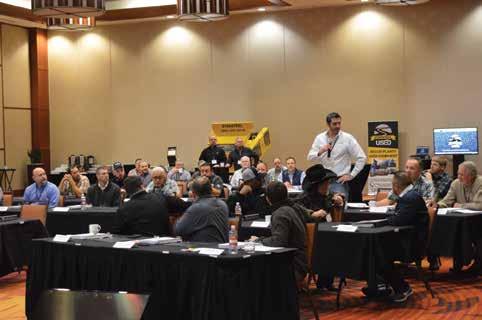
14 minute read
How We Can Incorporate Recycled Plastics in Asphalt Pavement
Editor’s Note: This article includes opinions of the author.
AAs a sea turtle conservationist, I want to see the floating island(s) of plastic pollution eliminated from our planet. Contrary to popular belief, we cannot use our roadway system as the new landfill. Even back in 1998-99, a researcher bemoaned the problems with using recycled glass in mix designs during a presentation at the University of Missouri-Rolla, giving a scathing review of Glasphalt.
I’ve not forgotten the spirit of his lesson.
Throwing trash into our roadway system is not the climate-change solution we want it to be when one considers the health, safety and environmental (HSE) implications alongside the lifecycle cost analysis of a pavement that may or may not perform to our standards for the lifetime that it should. What I mean is the asphalt industry currently designs low-carbon-footprint pavement systems that can last 35, 45, 65 years and beyond (see Sarah Redohl’s excellent report of a Perpetual Pavement Award winner on page 48). How much of the asphalt pavement’s carbon footprint savings do we sacrifice to increased maintenance activities by adding an unverified waste product?
In their “Interim Guidelines for the Use of Recycled Waste Plastic in Local Government Road Surfacing Applications,” published July 2021, Austroads’ Azeem Remtulla and Steve Halligan found an increasing interest in using recycled plastics, but found “no independent or comprehensive research has been undertaken into the effect of incorporating recycled waste plastic in asphalt and bitumen including HSE impacts, potential microplastic generation, leaching, fuming, reuse of asphalt incorporating recycled waste plastic and whole of life sustainability.”
With this article, we will look at the “whole of life sustainability” concept and use that to consider HSE impacts. We will also look specifically at the idea many environmentalist groups have suggested regarding the leaching of microplastics from pavement systems once recycled plastic waste becomes standard. There is a way to guard against that potential for harm, and the industry has already considered how to prevent it.
Let me oversimplify the incorporation of recycled plastic waste to make my initial point.
DON’T CROSS THE STREAMS
To incorporate recycled plastic waste in pavements, conveyors and machines powered by coal-fired electricity must sort the plastic streams. In the three-part series “Industry Incorporates Sustainability at Asphalt Production Plants,” which AsphaltPro published in 2019-2020, Malcolm Swanson, P.E., proprietor of e5 Engineers, Chickamauga, Georgia, reminded us that all plastics are polymers, but not all polymers are suited for use in all processes.
“There are several types of plastics to be considered,” Swanson shared. “But only two ways of incorporating the plastics into the asphalt. The two methods are ‘wet’ and ‘dry.’”
Krishna Srinivasan, president of Sripath Technologies LLC, Mahwah, New Jersey, listed the differentiation of methods as a top priority for the asphalt industry to keep in mind when incorporating any form of recycled waste plastic in an asphalt mix design.
“For dry modifiers, in many cases, the waste plastic functions as a filler,” Srinivasan said. “Even so, workability of the mix is important. The optimum binder content in mixes is defined by looking at density after a certain number of gyrations. If the plastic interferes with the packing, then more binder may be needed, obviously impacting cost of the mix.
“For wet modifiers, several factors come into play,” he continued. “The first is the sorting issue—separating out the different plastics and incorporating only those with melting points that are compatible with the processing of the binder. High viscosity in such systems is also an issue. In the case of partially melted plastics, the particle sizes of the unmelted materials may interfere with measurement of key properties needed for verification of the binder grade used in the mixes.
“Finally, one of the most dominant issues in waste plastics use in asphalt is the storage stability of the binder incorporating such plastics; often it is quite poor.”
Swanson listed for us the waste materials where researchers were focusing their efforts in 2019/2020; where researchers saw the best
Photo by Naja Bertolt Jensen on Unsplash
BUILT TO CONNECT
Efficiency and Productivity

Designed with safety and operator comfort in mind, the Shuttle Buggy® SB-3000 material transfer vehicle features adaptive cruise control, bright LED lighting, four-wheel steering for easy transport and ground-level maintenance access for added convenience. Operators can rely on clear sightlines and the ground operator is safely protected inside the structure of the machine. The Roadtec SB3000 is the perfect blend of traditional craftsmanship and modern technology.
potential for polymers/plastics to make their way into asphalt pavements with the best benefit for the system. He listed: • high-density polyethylene (PE-HD), commonly used to make grocery bags; • low-density polyethylene (PE-LD), used to make frozen food bags; and • polypropylene (PP), used to make microwaveable food containers.
Once the waste plastic items are sorted and selected, other machines must melt, manipulate or otherwise break down the waste product into pelleted, wax or fiber form for blending. It must then be transported to the terminal or plant where it will be injected inline to a liquid asphalt cement (AC), added to the aggregate weigh bridge for blending or another similar method to be discussed below.
In other words, the recycled waste plastic product is treated like an additive.
Because this recycled waste plastic additive does not naturally blend molecularly with asphalt—they are not compatible in nature—we must force the reaction via a modifier. The modifier’s purpose is to facilitate the recycling process. Once broken down, the recycled waste plastic additive often requires 2% to 4% of Polyphosphoric acid (PPA), by weight, to improve blending capability, as discussed in the January 2020 edition of AsphaltPro.
The first priority our industry must consider before incorporating recycled plastic in the asphalt mix design is the recycled plastic source and composition. It doesn’t take an expert in recycling to recognize there are differences in recyclate streams. To get a quality mix with recycled plastic included, the plastic may require modification to meet performance specifications of the city, state, region and so on. Experts in polymer and additive manufacture remind us that it will take the correct elastomeric compatibilizer to ensure the resultant asphalt mix can deliver a long-lasting road pavement performance, no matter the country or climate.
Add the modifier’s production to the whole of life sustainability concept we are discussing, but keep in mind, the modifier is not only making it possible to use recycled waste plastics in the mix design; it is often improving the properties of the recycled waste plastic so that the new mix design will continue to perform well upon placement. As these experts are showing us, the asphalt industry is not interested in increasing a mixture’s carbon footprint at the expense of pavement performance. That is creating a loss-loss.
Instead, if we must add steps that generate whole of life sustainability costs for the purpose of cleaning up plastic pollution, we would like to retain—if not improve—performance in the end. Let’s make it a win-win.
The good news is incorporating the recycled waste plastic additive and its modifier can be done in a way that offsets the carbon footprint increase. In the discussion below, we will see additive manufacturers offer information on this possibility, thus showing how the asphalt industry can turn the inclusion of recycled waste plastics into a win-win-win.
WET VS DRY ENERGY CONSUMPTION
The dry method of blending recycled waste plastics into the asphalt mix involves introducing the product as a dry additive—with its modifier entrained—directly into the hot aggregate. The wet method involves introducing the product to the liquid AC binder before adding the binder to the mix. As Swanson pointed out two years ago, “[i]ntroduction by wet method appears to be most likely to succeed; however, just because two materials exist in liquid state within a certain temperature range does not mean that they will automatically blend well. We are all familiar with oil and water.”
That’s where modifiers come in to facilitate blending, as well as performance characteristics.
Toby McCartney, CEO of MacRebur, Lockerbie, Scotland, stated: “Our products are designed to be mixed via the ‘dry process,’ which means that we don’t heat any plastics or bitumen before the asphalt is made. The polymer modification happens when the bitumen and aggregates are mixed in the drum.
“Asphalt containing waste plastics is made at the standard temperatures and is mixed for the standard times, which again helps keep the manufacturing process as energy efficient as it can be.”
McCartney explained how the MacRebur mix is delivered. “All MacRebur’s products have been designed with the asphalt production process in mind. Our products can be added in the same way that a fiber is added to make an SMA or via any additions system at an asphalt plant. For example, a weigh hopper can be used, or product can be added via the RAP belt or through a hatch—or through any other system that is in place at a plant looking to replace part of its imported bitumen with MacRebur’s waste plastics.”
Srinivasan shared with readers how energy consumption will depend on plastic type: “This would depend on the type of waste plastic being incorporated into the asphalt. Some polymers are easy to dissolve in the common range of temperatures used for binders, and here the energy requirements are low. Some others—including some virgin polymers used in manufacture of PMBs—require high shear and high temperatures for incorporation into asphalt. Here, obviously, the energy requirements are considerably higher.”
THE MICRO-DISCUSSION
Currently, conversations outside the asphalt industry don’t center on how to sort plastic waste for optimum efficiency or energy savings at the asphalt plant. When I discuss recycled waste plastics in asphalt pavement outside of mix design or paving circles, I am inundated with environmental justice warriors shaking their fists about microplastics escaping the system. Experts share how we can assuage their fears.
“Again, the answer depends on whether waste plastics are used as dry modifiers or wet modifiers,” Srinivasan said. “In the case of dry modifiers, leaching could be an issue, not only of the vulnerable molecular weight segments in the plastic, but also additives used to improve the processing or use of the plastic in its original, intended application. For wet modifiers, this is not an issue. A virgin polymer like Sripath’s PGXpand® melts into the asphalt during processing and it loses its original identity. In such cases, leaching out of the mix is not a concern.”
“The polymers used to modify a road are melted into the bitumen to form a homogenous mix and so there are no actual plastics

Managers Exchange

January 16-19, 2022
Operators Course
February 6-9, 2022 February 20-23, 2022
Book Early!
Space is limited.
Call your rep to book a spot. 800-826-0223
A 4-day training and technical conference o ered by
R
Join us for Hotmix University in Louisville, Kentucky. During the intense exchange sessions, participants enjoy a combination of lectures, hands-on workshops on actual equipment, break-out sessions and discussions, as well as fun times to facilitate networking among industry peers.
We limit our class size so we may allow productive interaction with instructors and among asphalt producers and operators. Those who have graduated from HU have raved about the practical benefits received during their time spent learning with us.
Our staff of instructors boasts over 1,500 years of combined experience in the asphalt industry but also in the broader rotary processing equipment world. This makes our agenda unique to any other training event. Here are just some of the topics covered:
Performance measures Best practices and how to improve Establish FACTS about your plant Specific plant components review Design and operation practices Heating and drying: burners and dryer/drums Baghouse and air systems Silo systems Recycle - RAP & RAS Electronic controls Preventive Maintenance and Minimizing Downtime Productivity Reliability Engineering Much more!
in the road, but instead a polymer-modified bitumen,” McCartney provided. He explained that prolonging the stable life of a pavement in any way reduces the amount of any microparticles that might be released.
When paving with plastics, we are integrating recycled plastics into the asphalt. As shown in this article, the recycled waste plastics are selected and separated from their streams. They’re processed into a usable form—I gave the example of pellets or fibers; some experts call them “shredded.” The modifiers we discussed chemically bind the recycled waste plastic to the asphalt mix. They become, as McCartney suggested, a homogenous mix; a blended unit from which microparticles are not leaching.
SOLVE PAIN POINTS
Avoiding leaching of microplastics is merely one pain point that departments of transportation may not yet have placed on their collective radar. I asked additive manufacturers what other challenges they are addressing for agencies and contractors/producers alike. A handful of additive manufacturers weren’t ready to share their secret sauce, thus are not included in this discussion.
McCartney shared that the MacRebur product addresses pain points for both the DOT and contractor, including, but not limited to: • The quality of roads. MacRebur’s MR6 product has been proven to enhance the performance of asphalt, which results in less maintenance of roads and a reduced cost for future maintenance. • For producers there is money to be saved, as MacRebur’s waste plastic products cost less than bitumen. [At press time, that differential was around £50 per tonne.] • MacRebur’s products have also been designed with ease in mind, requiring no change to the manufacturing process or from the surfacing contractor’s perspective.
Srinivasan’s Sripath Technologies is in the research and development stage for its plastics offering. The team is looking at a host of issues they would like their resulting product(s) to address.
“Obviously, the sorting—and the attendant characterization—issue is the first hurdle,” Srinivasan said. “What is the starting point raw material that we are working with? We all know that quality is dependent on the ingredients used in the binder/mix. And the answer we are finding varies quite a bit by country or region. Pre-qualification testing of the waste stream may be important here.
“The next issue is how do we get it into a form that can be easily used by the producer/manufacturer? What does it contribute to the properties of the binder/mix and how do we reliably and reproducibly control those properties? Stability is a big concern here.
“Finally, one big area of study is endof-life issues,” Srinivasan concluded. “Asphalt is the most recycled material in the USA. Responsible use dictates that whatever we do to incorporate waste plastics in


SIL3 PLe CAT3 PLd
All plastics are polymers, but not all polymers are suited for use in all processes.— Malcolm Swanson
asphalt does not degrade the recyclability of the RAP. For high RAP mixes containing Sripath’s ReLIXER® rejuvenator, we have been able to convince customers that the RAP from the resultant roadway can be recycled when the roadway reaches the end of its useful life. We want to be responsible stewards of the environment, and this dictates that any technology we introduce has the same degree of future recyclability.”
By pumping the brakes on the idea of turning roadways into landfills, the industry has encouraged the public at large to let it take the idea of recycling waste plastics one step at a time. The asphalt industry has an excellent record of accomplishment for reducing emissions, for increasing recycling abilities, and for taking the time necessary to perform carbon-reducing and carbon-neutral processes in the most planet-friendly manner possible. Incorporating recycled waste plastic is one more example of this good track record playing out before us.
One step I believe we need to take now is looking at the recycling of roadway systems that have incorporated recycled waste plastics. As both Austroads and the National Asphalt Pavement Association (NAPA) have alluded to in their guidance documents, asset managers must, at this time, perform their own assessments of how roadways will be treated in future. If diamond grinding a distressed pavement 25 or 30 years from now releases microplastics, it is not the treatment to perform on a system containing recycled waste plastics, according to this sea turtle conservationist.
“The issue that concerns me most is preserving the recyclability of pavements,” Swanson agreed. “As mentioned, it would be a disaster to find out 20 or 30 years down the road that “plastic” roads don’t recycle very well.” He cautioned that getting out and paving ahead of the research could result in future failures. “Failures that show up early can derail the whole effort. Failures that show up late have even worse consequences. I understand the frustration of contractors while waiting on research results that always seem to be one more research project away. At some point, you have to pull the trigger, but not before recyclability is proven.”
We are at a point in history where we can evaluate the methods used to design and place these environmentally sustainable structures. I would prefer we not be so hasty that we present ourselves with an environmental debacle 35 or 45 years from now. In fact, I see the opportunity before us to build an environmental win with logically sourced recycled waste plastics and their wisely planned modifiers.








